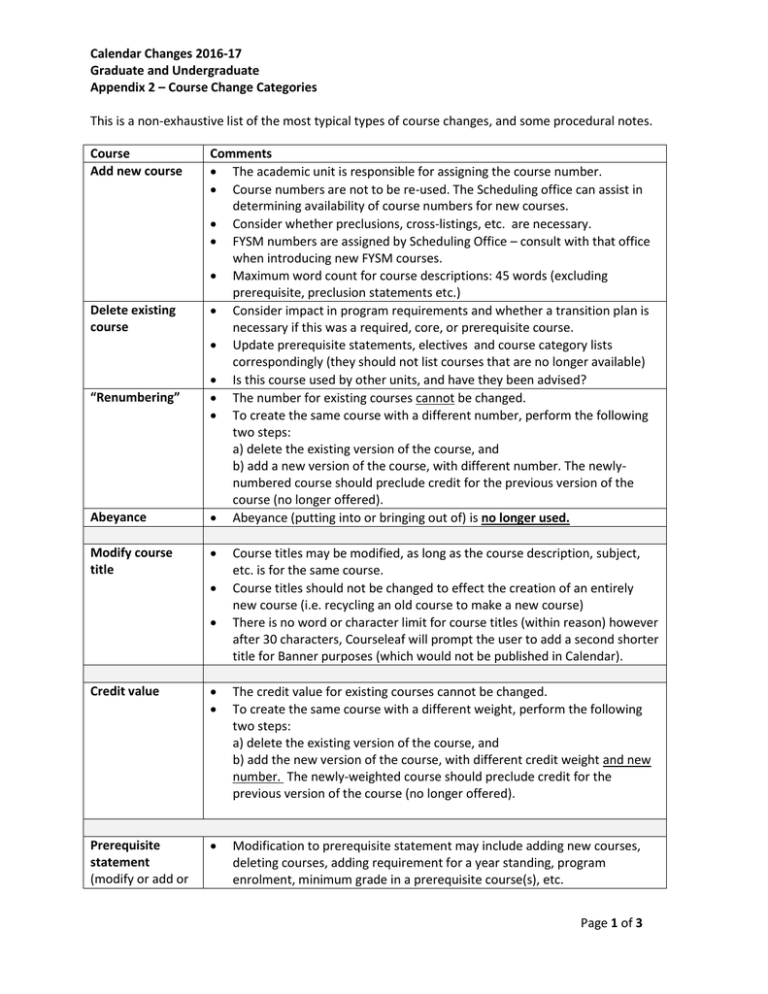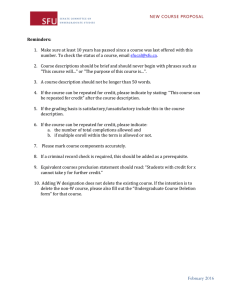Appendix 2: Detailed Course Changes
advertisement

Calendar Changes 2016-17 Graduate and Undergraduate Appendix 2 – Course Change Categories This is a non-exhaustive list of the most typical types of course changes, and some procedural notes. Course Add new course Delete existing course “Renumbering” Abeyance Modify course title Comments The academic unit is responsible for assigning the course number. Course numbers are not to be re-used. The Scheduling office can assist in determining availability of course numbers for new courses. Consider whether preclusions, cross-listings, etc. are necessary. FYSM numbers are assigned by Scheduling Office – consult with that office when introducing new FYSM courses. Maximum word count for course descriptions: 45 words (excluding prerequisite, preclusion statements etc.) Consider impact in program requirements and whether a transition plan is necessary if this was a required, core, or prerequisite course. Update prerequisite statements, electives and course category lists correspondingly (they should not list courses that are no longer available) Is this course used by other units, and have they been advised? The number for existing courses cannot be changed. To create the same course with a different number, perform the following two steps: a) delete the existing version of the course, and b) add a new version of the course, with different number. The newlynumbered course should preclude credit for the previous version of the course (no longer offered). Abeyance (putting into or bringing out of) is no longer used. Course titles may be modified, as long as the course description, subject, etc. is for the same course. Course titles should not be changed to effect the creation of an entirely new course (i.e. recycling an old course to make a new course) There is no word or character limit for course titles (within reason) however after 30 characters, Courseleaf will prompt the user to add a second shorter title for Banner purposes (which would not be published in Calendar). Credit value The credit value for existing courses cannot be changed. To create the same course with a different weight, perform the following two steps: a) delete the existing version of the course, and b) add the new version of the course, with different credit weight and new number. The newly-weighted course should preclude credit for the previous version of the course (no longer offered). Prerequisite statement (modify or add or Modification to prerequisite statement may include adding new courses, deleting courses, adding requirement for a year standing, program enrolment, minimum grade in a prerequisite course(s), etc. Page 1 of 3 Calendar Changes 2016-17 Graduate and Undergraduate Appendix 2 – Course Change Categories delete prerequisite statement) “Co-requisites” Cross-listed courses “Piggy-backed” courses Preclusionary statement Class format Courses no longer offered are not carried forward in prerequisite statements and should be removed (they can continue to be listed in Banner). Changes in prerequisites that affect or involve sister units require documented sister-unit consultation. Co-requisites are not used at Carleton, however the statement “may be taken concurrently” may be used, if desired. One course may be offered with two different numbers under different subjects. It is the same course. Students are sitting in same classroom, same instructor, same learning outcomes. Title and description should be identical. Cross-listed courses are at the same level (i.e. undergraduate:undergraduate or graduate:graduate) Changes in cross-listings that affect sister units require documented sisterunit notification and consultation. Appears in Calendar as “Also listed as ABCD 1234.” Similar to cross-listed courses, but spanning across graduate and undergraduate Students in same classroom, same instructor, but the work will be different for graduate and undergraduate. Units must declare annually, in both their graduate and undergraduate submissions which courses will be piggybacked. The course descriptions must be identical. In the graduate submission, units must indicate how course requirements will differ for graduate students. Changes or additions or deletions to piggyback statements that affect sister units require documented sister-unit notification and consultation Note that the respective undergraduate AND graduate faculty boards must approve all piggyback notations. Appears in Calendars as “Also offered at the graduate level, with different requirements, as ABCD 5678, for which additional credit is precluded”. (or undergraduate, as the case may be) Add new preclusion statement Modify or delete existing preclusion statement A precluded course is NOT the same thing as a cross-listed, identical course. Courses that preclude each other are different courses, but with sufficient content in common that credit cannot be granted for both. Preclusions are reciprocated. The statement must appear in both courses. If precluding courses from other academic units/disciplines, those units must agree to and list the preclusion in their own corresponding course at the same time. Appears in Calendar as “Precludes additional credit for ABCD 1001.” Any change to the class format statement including number of hours or method of delivery (web/online, for example) constitutes a formal curricular change with all the necessary approvals. Page 2 of 3 Calendar Changes 2016-17 Graduate and Undergraduate Appendix 2 – Course Change Categories Special topics Lists of courses All courses listed in the Undergraduate calendar must include a class format statement. Appears in Calendar as (for example) “Lecture two hours a week, laboratory one hour a week.” Topics included in curricular submission by the regular deadlines will be included in the Calendar. Consult Appendix 5 for guidelines concerning the inputting of Special Topics courses (graduate and undergraduate) as they relate to Banner and the transcript. Modifications to lists of courses (course categories, lists of acceptable electives to satisfy program elements, etc.) require approval, and, where courses from other units are impacted, documented sister-unit consultation. Page 3 of 3


